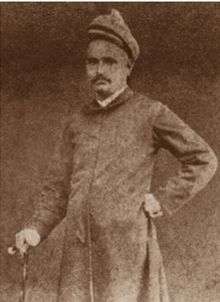Sakharam Arjun

Sakharam Arjun (sometimes Sakharam Arjun Ravut in official documents[1] but he did not use the caste-linked name in publications) (1839-16 April 1885) was an eminent physician and social activist in Bombay. An expert on Indian medicinal plants, he was one of the two Indian founding members of the Bombay Natural History Society[2][3]. He was the step-father of the pioneering woman physician Rukhmabai (1864-1955) after he married her widowed mother Jayantibai.

He studied at Elphinstone Institution and joined Grant Medical College as a Stipendiary Student in 1858. His tutor was Narayan Daji, brother of Bhau Daji. Arjun received a Licensiate of Medicine from the Bombay University in 1863.[4] He joined to teach medical botany and was made an assistant, the first Indian in the position, to William Guyer Hunter. He worked at the Jamsetjee Jeejeebhoy Hospital and was for sometime in charge of the ward for incurables.[5] He conducted experiments on the therapeutic value of oils like chaulmoogra and cashew nut in the treatment of leprosy. He was later appointed Assistant Surgeon. Sakharam was interested in public education on health and published Vaidyatatva (1869), Garbhavidya va Prasutikaran (1873), Vivahavidnyan (1877) among others. He also subscribed to The Theosophist writing a note on Physiology of Marriage in 1880.(p. 186) Sakharam Arjun supported his step-daughter Rukhmabai who was married as a child and refused to go to live with her husband. This led to a famous court case and Rukhmabai later went to study medicine in London (with the assistance of others like Edith Pechey Phipson) to become one of the first Indian women doctors. In 1883, Sakharam Arjun was one of two Indians (the other being Atmaram Pandurang) to found the Bombay Natural History Society.[6] Sakharam Arjun died before the Rakhmabai case came to an end.[7] He died on 16 April 1885 leaving Jayantibai (died 10 January 1904) and three sons from his first marriage, Vasantrao, Yeshwantrao and Raghunathrao.[8]
References
- ↑ Bombay University Calendar for the year 1883-4. p. 200
- ↑ Millard W. S. (1932). "The founders of the Bombay Natural History Society". Journal of the Bombay Natural History Society. Vol 35. No. 1 & 2: 196–197.
- ↑ Reuben, Rachel (2005). "The Indian Founders". Hornbill (April–June): 13–15.
- ↑ The Bombay University Calendar for the year 1886-87. p. 293.
- ↑ Abstract of the Report of the Leprosy Commission in India 1893. p. 57.
- ↑ Dhumatkar, Abhida S. (2004). "Balaji Prabhakar Modak - A nineteenth century science propagator in Maharashtra" (PDF). Indian Journal of History of Science. 39 (3): 307–334.
- ↑ Chandra, Sudhir (2008). "Rukhmabai and Her Case". In Chandra, Sudhir. Enslaved Daughters. Oxford University Press. doi:10.1093/acprof:oso/9780195695731.003.0001.
- ↑ AIR 1988 Bom 321, 1988 - Vaman Ganpatrao Trilokekar and others vs Malati Ramchandra Raut And others on 18 November 1987 - Bombay High Court
External links
- Sakharam Arjun 1879 Catalogue of the Bombay drugs: including a list of the medicinal plants of Bombay used in the fresh state.
- Life sketch